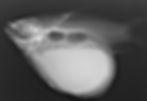William H Wildgoose MRCVS
Pet fish vet
Gonad disorders in goldfish
Disorders of sex organs are uncommon in goldfish and challenging to diagnose. Most are found when investigating abnormal swelling of the belly although eggs and blood may also be passed from the vent in some fish. Common goldfish appear to be affected more than fancy varieties. The subtle clinical features require careful examination under sedation, together with radiography and ultrasound scanning. The exact underlying causes are currently unknown and can be complex, often requiring histological examination of affected tissues. At present, there is no effective prevention or cure although experimental surgery may help some fish.

Externally, these cases are similar to other diseases and require diagnostic imaging (X-rays and ultrasound) to differentiate them from polycystic kidney disease and tumours. Initially, the swelling can be subtle but will increase over time, together with other general signs of illness (eg loss of appetite and lethargy). There was also some skin ulceration on the left flank.

There is a large area with a uniform radiopacity and well-defined margins in the lower abdomen. Above it, the loops of the bowel are compressed into the area below and overlying the swim bladder chambers, also seen as slightly opaque longitudinal structures within the outline of the chambers.

A large volume of blood-tinged fluid was aspirated with a needle and syringe, representing 30% of the fish’s body weight. Internal examination revealed a large cystic structure, which consisted of testicular tissue on histological examination. The other testis looked normal (asterisk).

Externally, these cases are similar to other diseases and require diagnostic imaging (X-rays and ultrasound) to differentiate them from polycystic kidney disease and tumours. Initially, the swelling can be subtle but will increase over time, together with other general signs of illness (eg loss of appetite and lethargy). There was also some skin ulceration on the left flank.